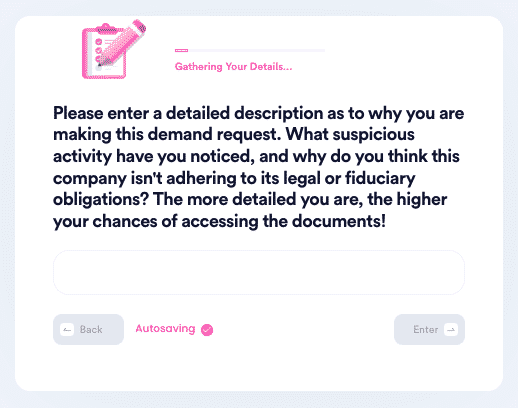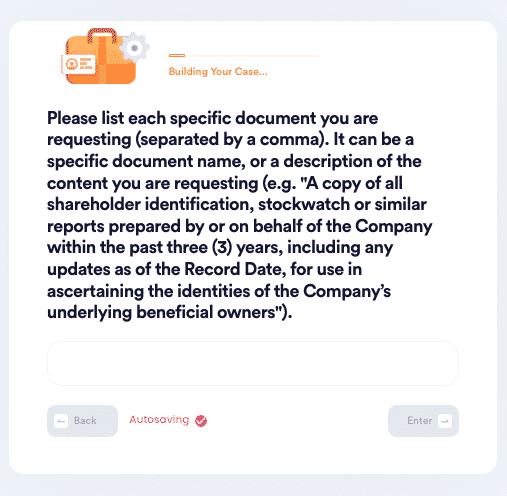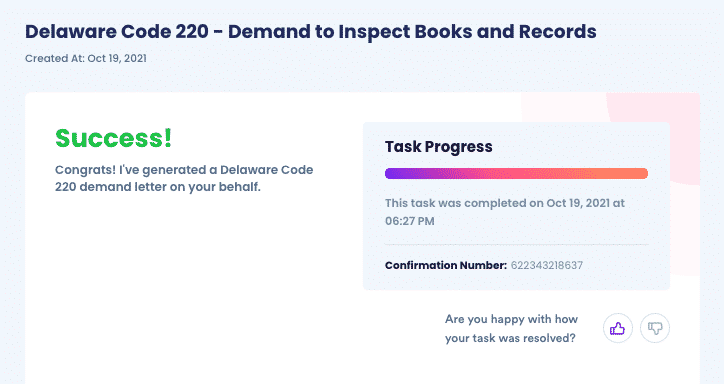How to Draft a Section 220 Demand Letter?
As a stockholder or director of a Delaware corporation, you have rights to inspect certain corporate documents. Delaware General Corporation Law (DGCL) specifies your rights to see and inspect the contents of those documents.
Most interested parties want access for many reasons. The most common ones are explained and listed here. For example, if you wish to see the list of stockholders, there should be no problem. However, if you want to see specific records that the corporation's executives consider to be privileged or questionable, they may not comply with your request. Before you submit your 220 demand letter, you should learn what information you have a right to see.
A corporation may refuse to comply with a request for different reasons. If the Board considers your demand is, for example:
- Frivolous or "idle".
- Simply about a decision with which you disagree.
- About an issue that may expose mismanagement in a department or project, maladministration, or illegal behavior.
- To do with decisions that may negatively affect the corporation's future or value in some way, but the board does not want those decisions investigated.
However, despite any refusal, Delaware law grants you rights and advantages when it comes to learning more about such concerns.
It takes time, effort, and knowledge to gain access to records. That access begins with filing a Section 220 demand letter.
The Section 220 Request to See Books and Records
There are rules to follow whether the corporation is willing or reluctant to release the information. The more reluctant the corporation is, the more difficult and legally complex it is to get the right outcome. To succeed as easily and quickly as possible, with a strong track record.
Such services are even more valuable if you are based outside Delaware and have little knowledge of DGCL structure and of the standards, requirements, and limitations established in Section 220.
Getting the information you need begins with submitting a request to the corporation via an approved letter in which you demand specific information. Anything in the letter which does not comply with Section 220 gives the corporation the opportunity to refuse the request. If you then take the matter to the Delaware Court of Chancery to force the release, that error will then be used to have the request legally denied.
The Format and Contents of the Demand Request Letter
Your letter should be formatted correctly, and its contents should be detailed and should clearly state the demands and the reason for the information. It is difficult for a corporation to refuse an accurate, detailed, and legally-supported demand. If it does refuse, it is more likely that the Court of Chancery will find in your favor.
Each topic should be given its own paragraph, and as much information as possible should be included to avoid misunderstanding or only partial compliance. The greater the detail, the greater the likelihood the corporation will comply or the court will find in your favor.
The Basic Format of the Demand Letter
The letter should contain:
- The name, address, and contact details of the sender. The sender may be an individual, a group, or an agent acting on behalf of the interested party.
- The date the demand is issued.
- The method of delivery. Both should be listed if the letter is delivered by hand and by a postal or courier tracking system.
- The addressee(s). This will include, for example, the corporation name and address, the Board of Directors, and the name of the specific person(s) receiving the demand.
- If the corporation has more than one location, and the requested information may be stored in them, all addresses must be included.
- A clear and obvious demand title, such as, Demand for Inspection of Books and Records of (Insert name of corporation) Pursuant to Title 8 Del. C. Section 220
- Begin with a suitable salutation.
The Basic Contents of the Demand Letter
The following examples are intended to:
- Offer pertinent examples of what can be requested and how it should be requested.
- Indicate the detailed wording so the recipient would not reasonably misconstrue or misunderstand the demand.
- Include only relevant information and the appropriate number of paragraphs in the demand letter.
| Paragraph 1 | Begin with an introductory paragraph confirming the person, group or company is/are recorded and beneficial holders of shares in (name of corporation) and/or they are recognized directors of same. |
| Paragraph 2 | Clarify the demand is in accordance with DCGL Section 220. For example, you may begin, Pursuant to Section 220 of the Delaware General Corporation Law, (do not abbreviate this) insert name(s) of the requester(s) hereby demand the right, during usual business hours, to inspect the following books and records of the Company and to make copies and extracts therefrom. The right to inspect may be carried out by our attorneys, consultants, or other properly designated agents. |
| Paragraph following | List, per numbered paragraph, each item to be released and made available for inspection. Include the reasons for the requested information. These may include, for example:
|
Supporting Paragraphs in the Demand Letter
Provide the overall and specific purpose for the requested information. Should the company not comply, and the matter goes to the next level, the court will look for a proper purpose to support each request. For example:
- We intend to investigate (insert decisions, processes, systems, etc. which resulted in the demand) in order to (insert potential actions to be taken after the information has been released including taking the matter to court, if that is an appropriate future step.)
- Confirm confidentiality in that anything learned, will not be shared with outside parties not named in the demand letter.
- Identify who should be contacted to question anything which is unclear or to deliver the requested documents.
- Include a verification of Power of Attorney status if an attorney or other agent is managing the process from here onwards.
Your Next Steps if You Cannot Do This on Your Own
The demand letter must be detailed, accurate, and must meet section 220 standards. Even though the letter is addressed to a corporation, it may be the first step in a battle. It is not acceptable under Section 220 for a stockholder or director to mean something which is not included in the letter, or for an outside agent to add their interpretation to the letter. The letter content and the interested party's intentions must be in unison.
To ensure that everything is correct, you may choose to Our strong track record is the easiest and quickest way for you to deliver a suitable .
How to Get Your Results With DoNotPay
All you need do is begin with giving us the basic information included in these five steps. If we require more detail, we will ask for it. You will see and approve the demand letter before it is delivered.
All you need to do now is follow these five steps:
- Search Delaware Code or Stock Inspection on DoNotPay.

- Confirm that the company you are hoping to inspect is a Delaware Corporation and that you are a stockholder.

- Tell us why you are requesting the information and what you plan on doing with it.

- Specify the names or types of documents you are requesting.

- That's it! DoNotPay will generate the formal request letter on your behalf and send it to the company.

What Else Can DoNotPay Do for You?
DoNotPay works across all companies, entities, and groups to deliver results. The issue may be , financial, technical, or something else. We are here to help. If you would like to learn more about other issues, you may find these two topics of interest:
- How to file a complaint against a company.
- Learn more about the Freedom of Information Act.
Today's world is complex. Resolving problems, correcting mistakes, and knowing you have the means to succeed all matter. Feel free to browse our services, and please keep us in mind if you need help or advice on just about any subject.
 By
By